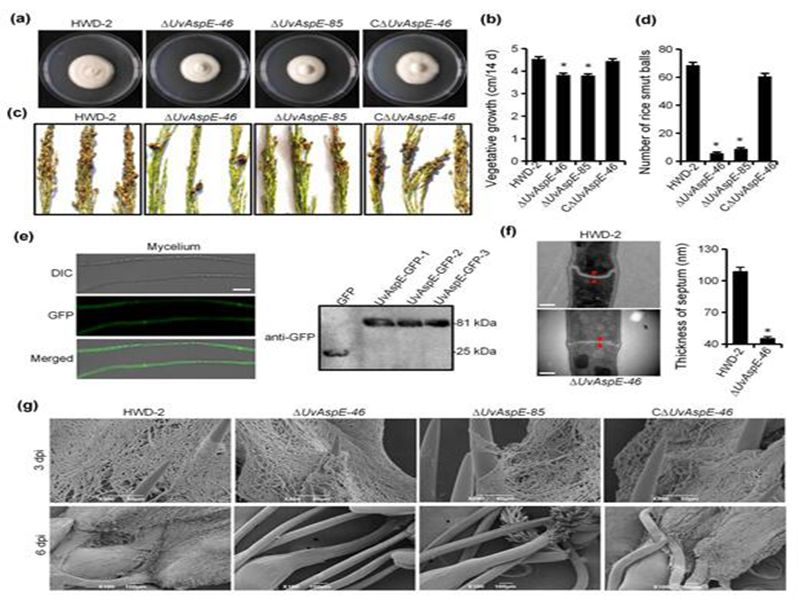The HZAU research team of rice false smut from the College of Plant Science & Technology developed transgenic RFS-resistant rice cultivars by silencing fungal-specific genes of Ustilaginoidea virens with a RNAi-based approach called host-induced gene silencing (HIGS). Their latest findings were published entitled “Host-induced gene silencing of fungal-specific genes of Ustilaginoidea virens confers effective resistance to rice false smut” in Plant Biotechnology Journal.
Rice false smut (RFS) caused by U. virens is one of the most important diseases in the majority of rice-growing areas worldwide. RFS is quiet prevalent in China, not only causing an annual yields loss of more than 150 million kilograms of farmland over 45 million mu (3 million ha), but also threatening human or animal health by producing cyclopeptide mycotoxins. Cultivar resistance is the most economical, effective and environmentally friendly approach to control RFS. However, at present, there is no effective screening method for resistance sources of RFS, which leads to the lag of identification of resistant varieties and the lack of high-quality resistant rice varieties and gene resources.
HIGS takes the important genes of U. virens development and pathogenicity as molecular targets, then produce small interference RNAs (siRNAs) that match these genes of the invading pathogen in the host plants. The siRNAs will be transported to the invading pathogen cells to specifically recognize the mRNA during infection, thereby silencing the target genes. The hyphal growth and virulence of U. virens are affected in this way, hence achieving the purpose of RSF prevention and control.

HIGs significantly enhances the resistance ability of the transgenic rice lines to U. virens.
After identifying UvAspE, a fungal-specific septin gene in U. virens, the researchers found that it was involved in the regulation of hyphal growth, septum development and virulence by gene knockout. To prevent the off-target effects of siRNAs, the fungal-specific transcription factors UvAspE, UvCom1 and UvPro1 were selected from the U. virens genome as RNAi target genes by comparative genome approach to develop transgenic rice cultivars with RFS resistance.
RNAi (UvAspE, UvCom1 and UvPro1 ) transgenic rice lines were then constructed for disease resistance detection and molecular verification. The previously developed efficient indoor inoculation system for RFS proved that the resistance ability of the transgenic rice lines to U. virens were significantly enhanced, the U. virens extension inside the glume was inhibited and the number of rice smut balls significantly was reduced.
The researchers found that the relative transcriptional levels of these three target genes (UvAspE, UvCom1 and UvPro1) were all significantly reduced in transgenic lines. Small RNA sequencing data showed that siRNAs mapping to UvAspE, UvCom1 or UvPro1 were significantly enriched in their respective transgenic rice line. In fluorescence in situ hybridization (FISH) assays, fluorescence signal was both observed in rice flower organ and infection hyphae of U. virens in the infected UvCom1RNAi, UvPro1RNAi and UvAspERNAi transgenic rice plants. These results demonstrated that siRNAs were translocated to fungal cells during infection, thereby reducing the transcript levels of the three genes in the invading hyphae of U. virens.
\
The transcript levels of U. virens reduced when siRNAs were translocated to fungal cells.
Taken together, the research results suggest that HIGS targeting the fungal-specific virulence genes in U. virens can be used as an effective approach to develop RFS resistant rice plants, thus providing new ideas and strategies for cultivating RFS resistant materials and enriching RFS resistant resources, which is a bottleneck problem in actual production.
Zheng Lu (associate professor from the College of Plant Science & Technology) is the corresponding author of the paper. Chen Xiaoyang (phD) is the first author who performed most of the experiments and data analyses. Pro Liu Hao, Luo Chaoxi, Huang Junbing, Chen Xiaolin, and Zhang Peixin (awarded master) provided technical support. Chen Xiaoyang, ZhengLu. and Tom Hsiang(Pro from University of Guelph) wrote and revised the manuscript. All authors have read and approved the final manuscript.
The research was supported by the National Natural Science Foundation of China and the national key R & D program.
Source: http://news.hzau.edu.cn/2021/1203/62138.shtml
Translated by: Liu Shuying
Supervised by: Wang Xiaoyan
